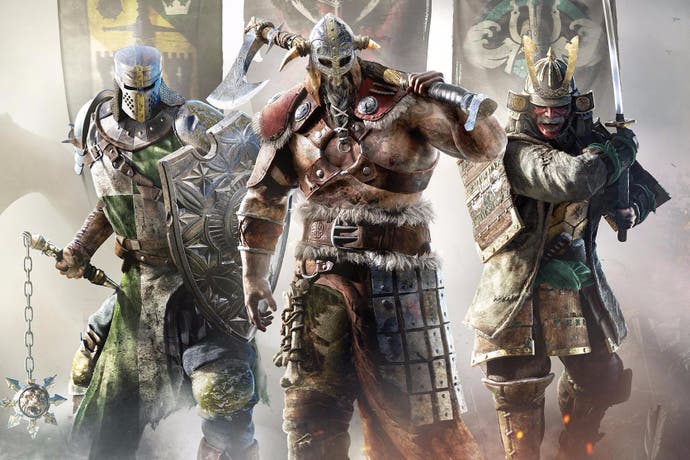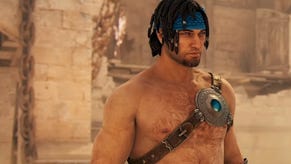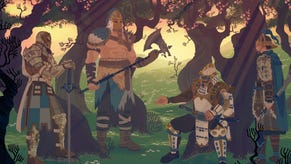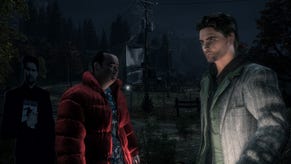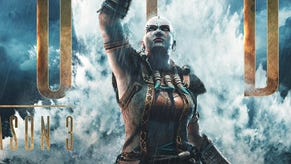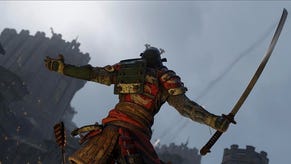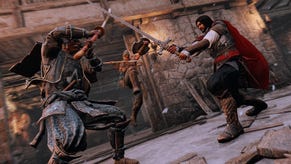For Honor review
A cut above.
It's a comeback for the ages. Well, almost. I'm standing at one end of a roofed wooden walkway in the grounds of a magnificent Buddhist monastery, health bar chiselled down to a stub, the sunset blazing at my elbow. That walkway is fast becoming notorious in For Honor's fledgling PvP community: it's all too easy, here, for a less civilised player to crash through your defences and shove you off the edge.
On the plus side, my adversary doesn't appear to be one of the latter. On the down side, my adversary is a Nobushi, a Samurai class equipped with a bladed spear whose basic tactic is to lacerate you with rapid, merciless prods, then retreat smugly while you bleed out - very effective indeed in a narrow environment. I'm playing an Orochi, a fencer who excels at counterattacks and darting footwork. Or at least, that's the idea. What I'm mostly excelling at right now is getting poked in the kidneys whenever I try to close in.
Among the things I suspect fighting game AI will never, ever capture are those moments when desperate players tap into unsuspected reservoirs of skill. In this case, it isn't so much a question of desperation as pride. What, was I going to let this broomhandle-wielding oaf polish me off with a status effect? Me, the very flower of bushido? I lurch forward suddenly like a drunk going in for a hug. The Nobushi retaliates with another flurry of jabs, but rather than trying to block I veer into them, my katana catching the point of the spear elegantly and guiding it over my head. An opening!
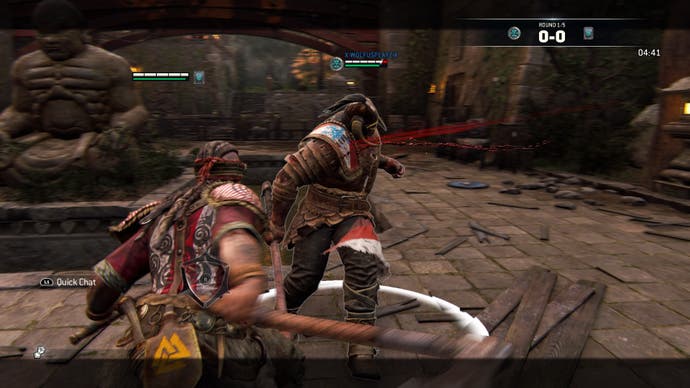
I land a trio of vicious cuts, bounce back and sink into a crouch. The Nobushi circles, evidently rattled, and I explode out of the crouch with a double-handed horizontal swipe - the Orochi's signature move. The Nobushi manages to angle her blade to deflect it, but I've already aborted the attack mid-swing and switched to a guard break, elbowing the other player in the diaphragm, then piling on a couple of meaty overhead chops while she regains her footing. It's my game to lose! I try to seal the deal with a slash to the right - and the Nobushi parries it irritably, slices me across the body and plants a boot in my jaw, knocking me over the cliff.
Though sadly under-served by its campaign and certain multiplayer modes, For Honor is another reminder that Uncle Ubisoft - patron saint of samey open worlds - can turn out the odd, absolutely cracking original every once in a while. It's a third-person brawler of marvellous grace and savagery, set in an alternative, earthquake-racked Middle Ages in which vikings, knights and samurai squabble for possession of collapsing forts and temples.
On paper For Honor may sound rather generic, with a roster of light and heavy attacks, stances, two or three-hit combos, parries, dodges, guard breaks, throws and unblockables, all of it governed by a quickly depleting stamina bar. But a number of things propel this familiar mix to great heights. One is simply the quality of the animation, which puts across weight, momentum and impact like few other fighting games - be it in the shape of a Valkyrie springing sideways while punching her spear through your guard, a Warden bundling a foe unceremoniously into a wall, or the way combatants stagger around each other, sides heaving, after exhausting their stamina in a gruelling rally. Ubisoft Montreal has such a track record for this kind of muscular nuance we're in danger of taking it for granted, but I've never seen the studio's resources applied to a game of this stripe, and the effect is transformative.
I've also never played a fighting game that uses Resident Evil 4's over-the-shoulder camera, Super Street Fighter 4 on 3DS aside - a feature that is brilliantly entwined with For Honor's stance system. Creative director Jason Vandenberghe has attracted mockery for terming the game "a shooter with swords", but this does speak to how For Honor calls upon a HUD setup familiar from games like Tom Clancy's The Division. Much as the latter displays ammo readouts and other info near your crosshairs, so For Honor wraps its stance indicators around your lock-on reticule - a shield outline split into segments corresponding to left, right and high stances, which flash red to warn you of an incoming attack. To block, you must change your stance by pushing right stick or moving your mouse towards the attack.
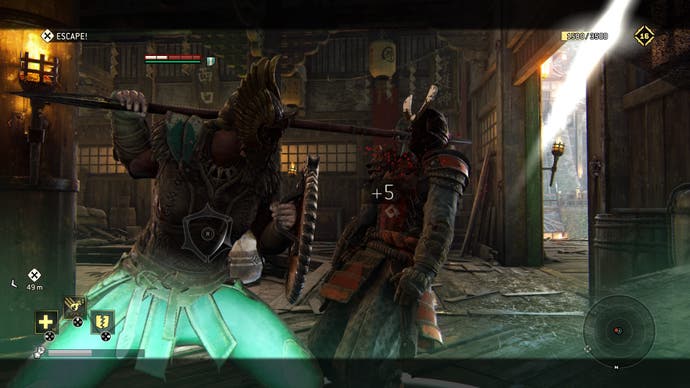
The slight delay involved may annoy those used to the crispness of 2D fighters (it's less noticeable with mouse and keyboard) but as Wesley wrote in his impressions piece, the system makes a virtue of its own sluggishness. It ought surely take time, after all, to shift a massive battle axe across your body, and fending off an opponent who switches stances constantly is a blistering test of your wits.
Another great virtue is the diversity of the game's 12-character launch line-up, and the finesse with which their skills are distinguished. The staunch Warden class is the Ryu of the team, comfortable in most situations thanks to a sturdy balance of range and speed, with a dependable two-hit upper longsword combo. After spending a few matches with her, you might try your hand at a brinkmanship option like the Berserker - a nippy, fragile barbarian whose spinning axeblows become uninterruptible once you've landed four hits. Or perhaps you'd rather double down on endurance as the Conqueror, a tank who can drop into a defensive crouch to repel all comers regardless of stance, and swing its morning star in circles to infuse heavy attacks with extra stamina.
Each character's moveset is smaller than is typical for a fighting game, but that's ultimately a strength - this isn't a brawler that relies on your committing knotty, overgrown combo trees to memory, and each class is a different beast depending on who you're fighting. The viking Raider has the reach and power to overwhelm frailer classes who haven't brushed up on their dodging and parrying, but try to steam through a Shugoki - think Smough from Dark Souls on his holidays - and you'll get knocked over and sat on. Thankfully, the game's tutorial options are quite robust, ranging from endless bot fights (level three bots are a serious and unpredictable menace) to character-specific video guides.
It all adds up to some of the most engrossing one-on-ones you'll find in a game. Two-versus-two brawls are also generally a blast - they pair players off in different corners of the map, and are thus effectively two duels in parallel with the winners facing off in the middle. You'll encounter the odd opposing pair who'd rather run away and team up, cue Benny Hill chase music, but this happens infrequently in my experience because duelling is such fun.
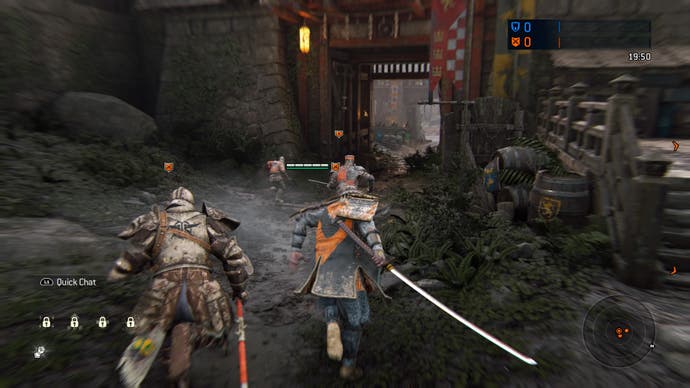
Ganking is also discouraged in a couple of ways. Firstly, you don't need to worry about which stance an attacker is in when you're locked onto somebody else - just angle your weapon in their direction to fend off their strikes. And secondly, blocking and parrying fill up a Revenge gauge which acts as a hard check to mobbing tactics. Activate Revenge and your character will essentially throw a Super Saiyan tantrum - sprouting bonus armour while bowling attackers over through sheer force of petulance. It confers such a huge advantage that you might actively seek out confrontations with groups in other modes, and the effect on the 2v2 playerbase has been to encourage people to stand back and let duels unfold, rather than sneaking in a cheap shot from behind.
Less entertaining, though not without their place, are the big team modes: basic no-respawns 4v4 Elimination, a Skirmish mode where you race to hit a certain score, and the showpiece mode Dominion, where players fight over three control zones alongside armies of diminutive AI footsoldiers. Here, the game's well-tempered metal is tarnished a little by weight of numbers: combat become less intimate and deft, more about surprising people, environmental kills and when all else fails, beating a hasty retreat in search of a health power-up.
These larger engagements allow you to customise heroes a bit using gear that is unlocked with in-game currency, or bought in packs with real money. They're more ways of tailoring your approach than "upgrades", as each increases some stats while decreasing others. You'll also get to muck around with Call of Duty-style secondaries such as bear traps or smoke grenades that break an opponent's lock-one. Most feel like a smidgeon of extra complexity for its own sake, and some of them are outright obnoxious - nothing conveys disrespect like squaring up to a foe, only for them to bean you Indiana-Jones-style with a flaming arrow.
There's still an element of skill to this side of the game - if you can feint and parry effectively in a crowd, I really don't want to fight you one-on-one - and the overclocked theatrics of Dominion are a pleasant break from the intensity of duelling. But it's not where For Honor sings. The same is true of the single player campaign, which I've left till last because it's among the most flavourless you'll ever come across - its scale and handsome looks torpedoed by abysmal writing and maps too obviously repurposed from multiplayer.
Split into three chapters encompassing five or six missions apiece, the story follows the rise of the Blackstone Legion, a renegade faction of uber-knights led by a sort of cut-price Darth Vader who wants everybody to fight endlessly because "all men are wolves", or something to that effect. The theme of war being humanity's natural state is harped on at some length, but never really develops, and characters don't so much have motivations as a critical mass of pent-up ire. You could excuse it all as a flawed commentary on how predisposed games in general are to conflict, I guess, but "bunch of arse" has more of a ring to it.
While following the Legion's trail across the continent, you'll be privy to aimless attempts at buddy comedy, including a throwaway joke about torture, and flaccid minigames such as on-rails horse-riding and our old friend Mr Mounted Turret. The campaign does a reasonable job of training you up, here and there, with bosses who serve as adverts for techniques such as attack cancelling, but for every challenging clash you can expect hours of hammering the heavy attack button while 'bots crumple like snowmen. Having spent a day with the multiplayer before giving the story a whirl, I actually felt like I was unlearning things about the game in the process.
All that's forgiven, however, the second you dive back into the multiplayer, where you'll at least have a few extra campaign-specific costumes to unlock for your troubles. If For Honor occasionally feels like a game at war with itself, its edge blunted by some less arresting modes and design-by-committee add-ons, the heart of the game beats strongly enough to overcome these blemishes.
The question, now, is how it will evolve. It's far too early to draw firm conclusions about the game's meta (the broader play of competitive strategies the fundamentals give rise to), but going by my own forays and forum chatter, For Honor skews a bit too sharply towards defensive play at higher skill levels. Whatever the differences between characters, the safest approach is often to let the other person make the first move, then dodge or parry and deal out a vengeful drubbing. If the battle is not yet won, however, it's off to a bloodthirsty beginning, and it's worth bearing in mind the example of Rainbow Six: Siege - another terrific multiplayer effort from Ubisoft that wasn't all it could be at release. Scruffier fixtures notwithstanding, this is one of the finest weapon-based fighters I've encountered - a game of mindgames and reversals in which you'll savour nothing quite so much as a glorious defeat.
